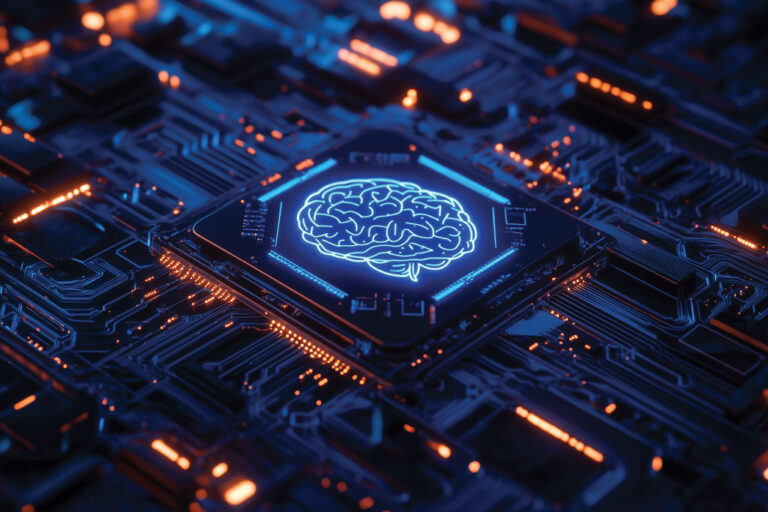FROM AUTOMATION TO AUTONOMY:
AGENTIC AI IN MANUFACTURING

I don’t know if you’ve heard, but there’s this new technology called AI (short for Artificial Intelligence) that’s been seemingly the only thing anyone in any field can talk about, whether it’s the arts, business, government, you name it.
Oh, you’ve heard?
Artificial Intelligence has attracted such attention and inspired so many articles that the topic risks becoming spoken about only in cliches: there are the doomsayers who predict the death of human ingenuity, or worse, there are the tech cheerleaders who tend to overpromise in their quest to hype the technology (the fact that many of its biggest boosters are also the ones poised to profit the most from it is surely not a coincidence.) The subgenres of AI discourse now include everything from ground breaking work using the technology in medical diagnostics to stories of teens driven to suicide by their chatbots. You have also probably heard about media replacing human writers with AI generated articles, but I assure you this one is entirely human written (except for one quote below.)
So, let’s cut through the noise a bit by focusing on one specific type of Artificial Intelligence and its potential uses in one specific industry. This article is about Agentic AI and its uses in manufacturing.
As defined by ChatGPT, Agentic AI “refers to AI systems that are not just passive responders (like answering questions or completing prompts) but instead can pursue goals, make decisions, and take actions over time.” Agentic AI is a more advanced type of AI than ChatGPT and similar chatbots, which depend on prompts; you ask it something, and it gives you an answer. Agentic AI is more sophisticated, instead of just reacting to prompts, it takes steps on its own initiative to meet a set objective, which can either be given to it or set by itself. Agentic AI is meant to be used for more complicated tasks than writing an email, generating an image, answering a search query (the things most people use ChatGPT to do). ChatGPT offered a simple way to understand it: think of it as Google Maps and Agentic AI as a self-driving car.
Agentic AI then has the potential to drastically reshape the manufacturing industry in ways ChatGPT’s ability to generate text or images never could. As technology finally reaches the necessary maturity for workplace adoption, here are just a few ways the technology could be applied to your manufacturing business:
Time Sheet Tracking
Traditional time sheets can only record and process data, leaving it to HR to interpret the information and adjust schedules manually, but Agentic AI could automatically manage time sheets for maximum efficiency. It could proactively anticipate attendance patterns and adjust the schedule automatically to reassign workers and account for staffing needs. With enough data it could automatically align attendance with production schedules while accounting for seasonal variations or workforce trends.
Production Insights
The typical static production report can only provide you with insights from the past, depending on the interpretations of management to apply it to future business decisions. With Agentic AI though, it would be possible to not only automate reporting but also analyze data in real time to predict inefficiencies that it could then recommend corrections for or even initiate the corrections on its own. Bottlenecks in production could be detected in real time and fixed with automatic speed or output adjustments further up the assembly line. Furthermore, Agentic AI would continuously adjust its recommendations based on its growing bank of production data to better identify evolving needs and link production with outside factors like shifting customer demand, labor availability, and supply chain readiness.

Supply Chain Control
Speaking of supply chains, possibly the single most talked about issue facing American businesses of the last few years. They have popped up in the national conversation over COVID, inflation, and tariffs, and now here they are in our AI talk. Agentic AI will not be able to make all supply chain problems go away, but they can help manage them. The current manual system of managing inventory depends on reorder points established in advance and set based on manual oversight. Agentic AI would be able to predict demand fluctuations based on data patterns and reorder automatically. Shortages and overstocking could be prevented by automatically analyzing sales and performance trends, as well as by correlating inventory with production schedules and data on customer demand. As the AI learns as it goes what works and what doesn’t, and is better able to adapt its analysis to a company’s specific trends and needs, it would be able to reduce holding costs and avoid supply chain disruptions.
Materials Research
In addition to managing supply chains, Agentic AI can also be used to decide what to use those supply chains to order. With its advanced processing abilities, Agentic AI can use data to come up with new concepts for goods and services that ordinary managers might miss. Agentic AI could determine which materials are feasible options to produce a product with, along with hidden costs and benefits they offer that might not be obvious up front.
Sales
Agentic AI doesn’t have to just be applied to the production end, it can also be used to help sell the final product. Again, Agentic AI offers the option to replace static data, this time on sales dashboards, with more dynamic software that will analyze vast amounts of data to detect trends and predict opportunities at a speed the human mind can’t match. AI could identify a declining sales trend and automatically adjust the price or develop a multi-step targeted marketing campaign to reverse the trend. It could automatically compare your prices with your competitors and adjust accordingly. And as it learns and adapts to company’s specific needs it could refine its adjustments to better tailor them to customer behavior and demand forecasts.
The possibilities Agentic AI offers are virtually limitless, with the potential to reshape any and every corner of the industry. If deployed properly, with the right data, it could transform manufacturing into something nimbler, more readily adaptable to changing market conditions and requiring a lighter workforce to operate. Still, the technology will not arrive overnight, and as with other AI systems, its early versions will be almost certainly rough and require multiple upgrades before they start to show the potential their boosters promised. But while it won’t happen tomorrow, the technology is coming, and manufacturers eager to stay competitive should start considering where it could be applied.




